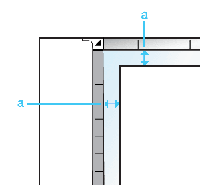 |
|
|
Move the document about 2 mm (0.1 inch) away from the edges of the document table to avoid cropping.
 a. Unreadable area of 2 mm (0.1 inch)
Make sure the document lies perfectly straight on the document table. Align the vertical and horizontal lines with the scales at the top and side of the document table.
If you are scanning with the ADF, see Adjusting the Color and Other Image Settings for instructions.
If you are scanning from the document table, see Adjusting the Color and Other Image Settings for instructions.
If you are scanning with the ADF, see Adjusting the Color and Other Image Settings for instructions.
If you are scanning from the document table, see Adjusting the Color and Other Image Settings for instructions.
If you are scanning with the ADF, see Selecting the Scan Resolution for instructions.
If you are scanning from the document table, see Selecting the Scan Resolution for instructions.
If your document is very thick or warped at the edges, cover the edges with paper to block external light as you scan.
If you are scanning with the ADF, see Adjusting the Color and Other Image Settings for instructions.
If you are scanning from the document table, see Adjusting the Color and Other Image Settings for instructions.
If you are scanning with the ADF, see Adjusting the Color and Other Image Settings for instructions.
If you are scanning from the document table, see Adjusting the Color and Other Image Settings for instructions.
If your original is printed on thin paper, images on the back may be visible to the scanner and appear in your scanned image. Try scanning the original with a piece of black paper placed on the back of it. Also make sure the Document Type and Image Type settings are correct for your original. If you are scanning with the ADF, see Selecting Basic Settings for details. If you are scanning from the document table, see Selecting Basic Settings for details. A ripple pattern (called moiré) may appear in a scanned image of a printed document. It is caused by interference from the differing pitches in the scanner’s screen and the halftone screen in your original.
In Office or Professional Mode, also deselect the Unsharp Mask Filter setting.
In Professional Mode, set the Screen Ruling of the Descreening Filter setting to an appropriate setting for your document.
If you are scanning with the ADF, see Adjusting the Color and Other Image Settings for instructions.
If you are scanning from the document table, see Adjusting the Color and Other Image Settings for instructions.
If you are scanning with the ADF, see Selecting the Scan Resolution for instructions.
If you are scanning from the document table, see Selecting the Scan Resolution for instructions.
In Professional Mode, select None for the B&W Option setting. Then try adjusting the Threshold setting.
See Converting Scanned Documents into Editable Text for instructions.
If you are scanning with the ADF, see Selecting Basic Settings for instructions.
If you are scanning from the document table, see Selecting Basic Settings for instructions.
If you are scanning with the ADF, see Adjusting the Color and Other Image Settings for instructions.
If you are scanning from the document table, see Adjusting the Color and Other Image Settings for instructions.
|



 The Edges of Your Document Are Not Scanned
The Edges of Your Document Are Not Scanned Top
Top
